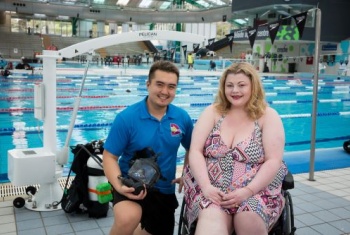NDIS participant, Chrystal Alexandroff is no fan of bureaucratese, which is one reason she loved the idea of using the new my NDIS app.
It’s also the reason she jumped at the chance to be one of the participants who helped co-design the app, which Chrystal, who is blind, has been successfully using to self-manage her plan for the past six months.
“I figured if I was gonna whinge about it when it became a public app, I’d like to have had a bit of input in the beta phase,” Chrystal said.
“And it’s been great. I use the app for most of my day-to-day dealings with the NDIS. There are still a couple of small things I’d like to see improved, but it’s not a big concern.
Overall, I think it’s pretty good and functional and I’m using it to manage all my claims.
“You can go in and see your budget, the breakdown of all your supports and what you have in there.
You can see how much capacity building you’ve got left, for example.
“I thought it would be more convenient and it is. It makes things easier and quicker, you can do three or four steps to make a claim, instead of 10.
It definitely cuts down on administrivia time.”
Sceptical about whether providing honest feedback about the app would have real results, Chrystal says she’s been pleased by the collaborative co-design process.
“I got into a meeting and I told them I’m really over this bureaucratic double speak,” she said.
“There were all these words in there about what was available, what was allocated and what was spent that just didn’t make sense.
“Honestly, after I had my say, I thought that’s good, but nothing much will probably come of it.
Then a while later I noticed all that wording around funding and so forth had been changed a bit, and it was much better.
So now it makes sense, and should make better sense for everybody.”
Blind since soon after birth, Chrystal says she was also sceptical about joining the NDIS, but the Scheme has helped to turn her life around.
“I was sort of basically dragged into the NDIS kicking and screaming because I just didn't want to know about it,” she said. “I was on block funding and was quite comfortable you might say.
“But it’s like night and day – night before, and day now. I wouldn’t want to go back to the way I was living prior to getting on the NDIS. I didn’t have enough support for quality of life.
“I feel I became almost borderline agoraphobic.
I sort of fell in love with my couch and was quite happy to stay in my house and not really go anywhere unless I had to for shopping.
“Now, my NDIS funding is a lot more flexible, and I can employ support workers who take me out.
It's more about the social aspects and things for me and being able to access things in the community that would otherwise be a bit difficult, like the gym, for example, or rock-climbing, which I also enjoy.
“I’ve dropped a bunch of weight, about 10 or 20 kilos because I’m eating better and taking better care of myself.
It has definitely helped me to get out and about more, and be less in love with my couch and more in love with life.”
Chrystal also uses her NDIS funding to access other supports, including assistance for house-cleaning and lawn-mowing, and a visual interpretive service called AIRA, which helps her to navigate her way around her community.
She hopes to increase her community participation and travel in the future.
“I think basically my goal is to be a bigger, better member of the community and just continue to feel good and vibrant,” she said.



